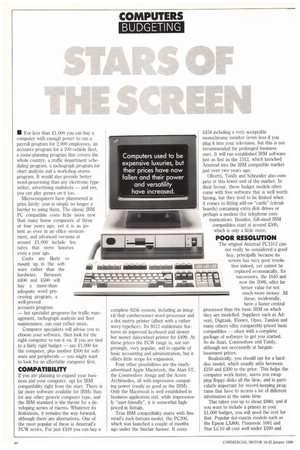POOR RESOLUTION
Page 42

Page 43

If you've noticed an error in this article please click here to report it so we can fix it.
The original Amstrad PC1512 cannot really be considered a good buy, principally because its screen has very poor resolu
1.tion indeed, yet cannot be replaced economically. Its successors, the 1640 and
now the 2086, offer far better value for not much more money. All these, incidentally, have a faster central processor than the basic IBM on which they are modelled. Suppliers such as Advent, Digitask, Elonex, Opus, Tandon and many others offer comparably-priced basic compatibles — often with a complete package of software to get you started. So do Atari, Commodore and Tandy, although not necessarily at bargainbasement prices.
Realistically, you should opt for a harddisc model, which usually adds between £250 and £300 to the price. This helps the computer work faster, saves you swapping floppy disks all the time, and is particularly important for record-keeping programs that have to access a lot of different information at the same time.
This takes you up to about £880, and if you want to include a printer in your £1,000 budget, you will need the rest for that. Popular dot-matrix models such as the Epson LX800, Panasonic 1081 and Star LC10 all cost well under £200 and give prwntable "near letter-quality" (NLQ) printing, albeit slowly. Daisywheel printers from Juki or Brother give quality as good as a typewriter's, but at the expense of cost, speed and noise. You might be better off spending £300-2500 on a better dot-matrix printer instead.
Laser printers offer better quality than either of the other types, but cost at least 21,000 (some are two or three times as much) and they cost much more to run.
Exclude the printer from your budget and the choice of computer becomes much wider. That £1,000 (or perhaps a little more) will just about buy you the equivalent of the next model up in the IBM range, the much faster AT, complete with hard disk as standard. This uses a different microprocessor from the basic PC (Intel's 80286 as opposed to the 8088 or 8086) and the difference is striking.
Operations which take seconds on a standard PC seem to happen almost instantaneously. Processing a complex payroll or accounts program will take minutes less — which means the computer will be more available for other uses. You will probably not get a colour monitor at this price, but routine business programs don't really need one. Opus sells a hard disk model with highresolution colour monitor for 2999, but this has a slower processor.
If you are determined to have a colour model, an EGA system (Extended Graphics Adaptor) is the minimum you should accept. Including appropriate circuitry in the computer, it will add 2300 or more to the monochrome price, but the cheaper CGA standard (Colour Graphics Adaptor) offers poor text resolution, and a relatively-feeble range of colours. The upand-coming standard is VGA, which is even better than EGA, but costs more.
































































































